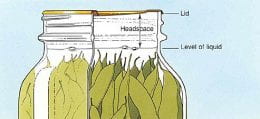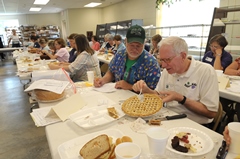
Headspace is the space in the jar between the inside of the lid and top of the food or its liquid. The amount of headspace needed depends on the type of food being processed.
If the jars are filled too full the contents may boil out during processing. Solids or seeds may be caught under the sealing compound and prevent the jar from sealing.
If too much headspace is left at the top of the jar, the processing time may not be long enough to drive out all the extra air from the top of the jar. This would mean that a tight vacuum seal may not be formed. Also, the air left inside the jar could cause the food to discolor.
For the correct headspace for each food, check the processing directions for each specific food.
Starchy foods, such as beans or potatoes, tend to swell when heated and therefore require more headspace.
The extent of expansion during processing it determined by the air content in the food and by the processing temperature. Air expands more at higher temperatures.
The USDA Complete Guide to Home Canning recommends the following headspace measurements:
- Jams and Jellies—1/4 inch
- Fruits and tomatoes to be processed in a boiling water bath—1/2 inch
- Low acid food to be processed in a pressure canner—1– to 1-1/4 inches
Source: USDA Complete Guide to Home Canning and National Center for Home Food Preservation





